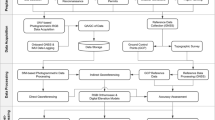Abstract
Among the many means of acquiring surface information, low-altitude light detection and ranging (LiDAR) systems (e.g., unmanned aerial vehicle LiDAR, UAV-LiDAR) have become an important approach to accessing geospatial information. Considering the lower level of hardware technology in low-altitude LiDAR systems compared to that in airborne LiDAR, and the greater flexibility in-flight, registration procedures must be first performed to facilitate the fusion of laser point data and aerial images. The corner points and edges of buildings are frequently used for the automatic registration of aerial imagery with LiDAR data. Although aerial images and LiDAR data provide powerful support for building detection, adaptive edge detection for all types of building shapes is difficult. To deal with the weakness of building edge detection and reduce matching-related computation, the study presents a novel automatic registration method for aerial images, with LiDAR data, on the basis of main-road information in urban areas. Firstly, vector road centerlines are extracted from raw LiDAR data and then projected onto related aerial images with the use of coarse exterior orientation parameters (EOPs). Secondly, the corresponding image road features of each LiDAR vector road are determined using an improved total rectangle-matching approach. Finally, the endpoints of the conjugate road features obtained from the LiDAR data and aerial images are used as ground control points in space resection adjustment to refine the EOPs; an iterative strategy is used to obtain optimal matching results. Experimental results using road features verify the feasibility, robustness and accuracy of the proposed approach.








Similar content being viewed by others
References
Abedini, A., Hahn, M., & Samadzadegan, F. (2008). An investigation into the registration of LIDAR intensity data and aerial images using the SIFT approach. International Archives of the Photogrammetry, Remote Sensing and Spatial Information Sciences, 37, 169–176.
Awrangjeb, M., Ravabaksh, M., & Fraser, C. S. (2010). Automatic detection of residential buildings using LIDAR data and multispectral imagery. ISPRS Journal of Photogrammetry and Remote Sensing, 65, 457–467.
Bovolo, F. (2009). A multilevel parcel-based approach to change detection in very high resolution multitemporal image. IEEE Geoscience and Remote Sensing Letters, 6, 33–37.
Cheng, L., Tong, L., Chen, Y., Zhang, W., Shan, J., Liu, Y., et al. (2013). Integration of LiDAR data and optical multi-view images for 3D reconstruction of building roofs. Optics and Lasers in Engineering, 51, 493–502.
Choi, K., Hong, K., & Lee, I. (2011). Precise geometric registration of aerial imagery and LIDAR data. ETRI Journal, 33, 506–516.
Clode, S., Rottensteiner, F., Kootsookos, P., & Zelniker, E. (2007). Detection and vectorization of roads from lidar data. Photogrammetric Engineering and Remote Sensing, 5, 517–535.
Deng, F., Hu, M., & Guan, H. Y. (2008). Automatic registration between LiDAR and digital images. International Archives of the Photogrammetry, Remote Sensing and Spatial Information Sciences, 37, 487–490.
Edelsbrunner, H., & Mücke, E. P. (1994). Three-dimensional alpha shapes. ACM Transactions on Graphics, 13, 43–72.
Guo, Y., Bennamoun, M., Sohel, F., et al. (2014). 3D object recognition in cluttered scenes with local surface features: a survey. IEEE Transactions on Pattern Analysis and Machine Intelligence, 36(11), 2270–2287.
Höfle, B., & Rutzinger, M. (2011). Topographic airborne LiDAR in geomorphology: A technological perspective. Zeitschrift für Geomorphologie., 55, 1–29.
Joerg, P. C., Morsdorf, F., & Zemp, M. (2012). Uncertainty assessment of multi-temporal airborne laser scanning data: A case study on an Alpine glacier. Remote Sensing of Environment, 127, 118–129.
Kwak, T. S., Kim, Y. I., Yu, K. Y., & Lee, B. K. (2006). Registration of aerial imagery and aerial LiDAR data using centroids of plane roof surfaces as control information. The KSCE Journal of Civil Engineering, 10, 365–370.
Licciardi, G. A., Villa, A., Dalla Mura, M., Bruzzone, L., Chanussot, J., & Benediktsson, J. A. (2012). Retrieval of the height of buildings from WorldView-2 multi-angular imagery using attribute filters and geometric invariant moments. IEEE Journal of Selected Topics in Applied Earth Observations and Remote Sensing, 5, 71–79.
Lu, Z., Wang, F., Chang, Y., Liu, Y. (2007) Edge detection based on adaptive structure element morphology. In Proceedings of 2013 IEEE International Conference on Automotive Logistics (pp 254–257).
Mishra, R. K., & Zhang, Y. (2012). A review of optical imagery and airborne LiDAR data registration methods. The Open Remote Sensing Journal, 5, 54–63.
Otsu, N. (1979). A threshold selection method from gray-level histograms. IEEE Transactions on Biomedical Engineering, 9(1), 63–66.
Shorter, N., Kasparis, T. (2008). Autonomous Registration of LiDAR Data to Single Aerial Image. In Proceedings of the IEEE International Geoscience and Remote Sensing Symposium (vol. 5, pp. 216–219).
Silván-Cárdenas, J. L., & Wang, L. (2006). A multi-resolution approach for filtering LiDAR altimetry data. The ISPRS Journal of Photogrammetry and Remote Sensing, 61, 11–22.
Susaki, J. (2012). Adaptive slope filtering of airborne LiDAR data in urban areas for digital terrain model (DTM) generation. Remote Sensing, 4, 1804–1819.
Tournaire, O., & Paparoditis, N. (2009). A geometric stochastic approach based on marked point processes for road mark detection from high resolution aerial images. The ISPRS Journal of Photogrammetry and Remote Sensing, 64, 621–631.
Wang, L., Neumann, U. (2009) A robust approach for automatic registration of aerial images with untextured aerial lidar data. In Proceedings of CVPR (pp. 2623–2630).
Zhang, J. Q., Pan, L., & Wang, S. G. (2003). Photogrammetry (pp. 36–42). Wuhan: Wuhan University Press.
Zhu, C. Q., Yang, Y., Wang, Q. S., Zou, F (2006). Total rectangle matching approach for road extraction from High-resolution remote sensing images. In Proceedings of SPIE (pp. 641925–641925).
Zitova, B., & Flusser, J. (2003). Image registration methods: a survey. Image and Vision Computing, 21, 977–1000.
Acknowledgements
This work was supported in part by National Science and Technology Pillar Program under Grant No. 2014BAL05B07 and by National Natural Science Foundation of China under Grant No. 41501562.
Author information
Authors and Affiliations
Corresponding author
About this article
Cite this article
He, P., Wang, X., Wan, Y. et al. Automatic Registration Between Low-Altitude LiDAR Point Clouds and Aerial Images Using Road Features. J Indian Soc Remote Sens 46, 1963–1973 (2018). https://doi.org/10.1007/s12524-018-0851-6
Received:
Accepted:
Published:
Issue Date:
DOI: https://doi.org/10.1007/s12524-018-0851-6




